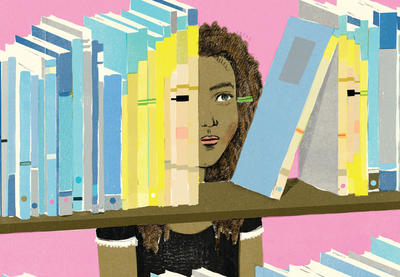Dr. Neal Lester, a professor of English at Arizona State University, says his journey into studying children’s literature began 30 years ago. A parent of biracial children (he is African American and his wife is Italian Argentinean), Lester went searching for children’s books that reflected his family—and found only a few.
His experience isn’t surprising considering that—even today—only a small percentage of children’s books are written by or about people of color. The Cooperative Children’s Book Center at the University of Wisconsin-Madison receives most trade books released by large publishers—and many smaller ones—in the United States. Of the approximately 3,600 books they received in 2012, fewer than eight percent were about people of color.
And just because a book depicts people of color does not mean it necessarily sends the right message. Lester points out that the long-awaited Disney story of a black princess, Tiana, in the film The Princess and the Frog has serious flaws, not the least of which are that she spends more time being a frog than a princess and that she works as a cook. (Other Disney princesses don’t have careers.)
Perhaps even more troubling, says Lester, are books, such as collections of Mother Goose rhymes, that privilege heteronormativity—the assumption that characters are and should be heterosexual—through overemphasis on marriage and living happily ever after. “These children’s books set up these ideals and values that can be very problematic,” he says.
Gender inequity in children’s books is also a continuing issue. According to a 2011 study by Florida State University, male lead characters in children’s stories are the norm, even when the characters are animals. The study, which examined nearly 6,000 children’s books published in the United States between 1900 and 2000, found that 61 percent had male central characters. A mere 37 percent had female central characters. A 2007 study by Centre College found similar discrepancies, and researchers noted no reduced sexism in the current children’s books they reviewed compared to those published in the 1980s and '90s.
They’re Just Kids
Racial inequity, gender stereotypes and heternormativity are heavy topics, and some people may wonder if early childhood is the proper time to address social justice issues with children. But educators and children’s authors say the years from kindergarten to second grade are ripe for discussing diversity and equity because children are forming their own identities and becoming aware of differences in the people around them.
In fact, the authors of the Centre College report wrote that gender inequity in children’s books probably has “serious effects” on kids between the ages of three and five because they are just beginning to form ideas about gender roles.
Kelly Starling Lyons, an African-American children’s book author and frequent presenter at schools and libraries, was 22 when she first saw a black face on the cover of a children’s book, Something Beautiful by Sharon Dennis Wyeth. Now, Lyons writes books that celebrate family life and invoke history—including the legacy of slavery—in an honest, child-friendly way.
“I want to make sure all children can see themselves in books,” she says. “I want children to know their history matters—they matter.”
Murrial Jarrett, a first-grade teacher at Harper Elementary School in Riverdale, Ga., agrees. She says the children in her predominantly black classroom near Atlanta “are like little sponges” when it comes to acceptance of others. This year she has several Latino students, one Pakistani student and no white students.
“They are just beginning to realize that people are a little different,” she says. “They are very accepting of each other. If one child is crying in the room, they are all concerned. They are friends with each other.”
“I actually think young children have the most open minds,” says Monica Brown, a Peruvian-American author of children’s books about multiethnic identity. “They haven’t been inundated by mass culture. They have an innate sense of fairness. Kids are always saying, ‘That’s not fair!’ When they walk in others’ shoes, they can be empowered to want change.”
The Teacher’s Bookshelf
Young children need books that reflect their own identities and portray a range of cultures, nationalities, immigration statuses, genders, socio-economic classes, sexual orientations and family structures—books they may not find at home or even in the local library.
“It’s important that we have these books in our schools because not every family can afford to own them,” says Brown. “Every child has a right to literature that isn’t stereotypical or reductive and doesn’t dishonor them as people.”
Lester, who now specializes in African-American literature—especially children’s picture books—says there are no perfect books, but he offers some tips for making your classroom library as inclusive as possible.
“You should give a range of books, and use a checklist,” he says. “Are there characters of color? Is the language inclusive? Is there a savior mentality? … You have to be aware of these issues. You have to educate yourself on how to look at representations and how to imagine a world where everyone is valued.”
An Inclusive Children’s Reading List
Benjamin and the Word / Benjamín y la palabra
by Daniel A. Olivas
Black Is Brown Is Tan
by Arnold Adoff
The Boy Who Harnessed the Wind: Young
Readers Edition
by William Kamkwamba
Brick by Brick
by Charles R. Smith, Jr.
Courtney’s Birthday Party
by Loretta Long
Ellen’s Broom
by Kelly Starling Lyons
The Great Big Book of Families by Mary Hoffman
Kate and the Beanstalk
by Mary Pope Osborne
Marisol McDonald Doesn’t Match / Marisol McDonald no combina
by Monica Brown
Mufaro’s Beautiful Daughters: An African Tale by John Steptoe
My Princess Boy
by Cheryl Kilodavis
Nappy Hair
by Carolivia Herron
Oh the Things Mommies Do! What Could Be Better Than Having Two?
by Crystal Tompkins
The Patchwork Path:
A Quilt Map to Freedom by Bettye Stroud
The President Looks Like Me & Other Poems
by Tony Medina



0 COMMENTS